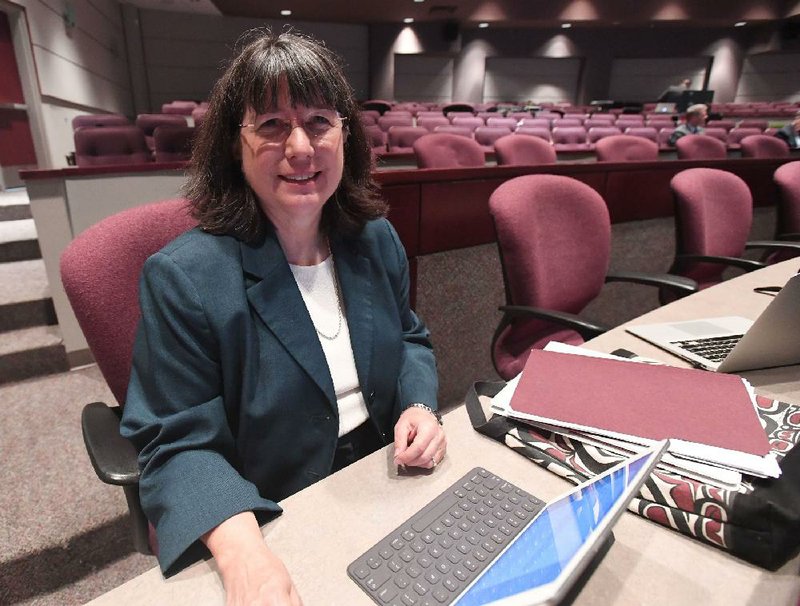The University of Arkansas at Little Rock should prioritize fulfilling its mission versus meeting statistical goals with hollow inherent value, like enrollment, Chancellor Christina Drale told faculty and staff members Friday during the fall University Assembly meeting.
Enrollment has been the primary scourge of the university's recent budget troubles. Revenue from enrollment hasn't matched expectations in several of the past 10 years, and budgets haven't shrunk permanently to accommodate for a student population that is roughly three-quarters of what it was a decade ago.
Earlier this year the university began strategic cuts to administrative bodies and reduced academic programs, effective once students graduate or otherwise leave the university.
A part of the planning process has been the Institutional Effectiveness Committee, which started in 2018 and is on its way to becoming a permanent part of the university's structure. The committee evaluates and assesses numeric values to every university department and office to determine whether it's central to the university's mission and run effectively.
The University Assembly approved Friday making the committee, composed of faculty and staff representatives, permanent but must vote a second time to make it official, in April.
The university faces a loss of $6.5 million this year, after budgeting for a $9.9 million loss this year. That's because of an enrollment drop that wasn't as drastic as expected, only 6.2% compared with 10.5%. The university enrolled 8,019 students this fall, not including concurrently enrolled high school students.
Higher enrollment is only a desired outcome of the university's commitment to its mission, Drale said. For too long, she told the University Assembly, the administration has sought higher enrollment without a clear vision.
The university is an urban research university, and it should play a bigger role in the community through education, community work and research, she said.
Drale unveiled on Friday four priorities for the university that, if fulfilled, should result in better outcomes for the university's bottom line.
The priorities, in order, are:
• Increasing access to higher education and subsequent student success;
• Providing the "right mix" of liberal arts and pre-professional programs to put students on viable career paths.
• Applying a creative work and research efforts to real-life issues.
• Engaging with the community through education, research and service projects.
"Now, some of you might be asking yourselves, what about the budget and resources? What about enrollment? Aren't these important institutional priorities as well?" she said. "I would argue that these objectives are very important, but they are a means to an end, not the end in itself."
Some of the university's more recent, revamped enrollment efforts, though partially beset by the coronavirus pandemic, did not result in more freshmen this fall, as expected.
Though the numbers of students applying to the university and admitted to it rose significantly from previous years, the university turned only about 29% of its admitted applicants into students this fall.
"That'a low figure," Cody Decker, UALR's vice chancellor for student affairs and chief data officer, told the University Assembly. "That's not ideal. That's not what we want."
That number, known as a yield rate, was 42% last fall, he said.
The National Center for Education Statistics holds statistics on admissions of undergraduate first-time, degree-seeking students at colleges and universities nationwide. UALR has relatively high transfer and graduate programs, but as far as those undergraduate students go, the university has had much lower yield rates than most public universities in Arkansas.
In fall 2018, the latest year for which data is available, UALR had a 28% yield rate for those students, second-lowest among the eight public Arkansas universities in the database, according to research by the Arkansas Democrat-Gazette. Rates among the six schools with higher rates ranged from 33% at Henderson State University to 40.3% at the University of Central Arkansas.
Decker said Friday that the university is looking at ways to engage applicants in the months between when most of them apply (in the fall) and when they eventually would begin registering (in late spring). The university also will start awarding scholarships traditionally awarded in the fall to students who first enroll in the spring.
The university developed a 56-page strategic plan for recruitment and retention of students last December, which Drale said she leveraged for foundation gifts this spring. The university now has a fully endowed student success center designed to improve retention and graduation and is offering more need-based scholarships.
The university will open a career center in January, using funds from the Donaghey Foundation, and Donaghey money also will be used to invest in other student success programs and diversity initiatives that haven't had much attention in recent years, she said.
Drale also has created two committees dedicated to examining race and ethnicity issues on campus. One will examine programs and practices with unintended consequences.
That's also been a push of the Student Government Association, President Landon DeKay told the University Assembly. The association had pitched a similar committee to tackle any identified issues, as well as efforts to engage more students with the university.
